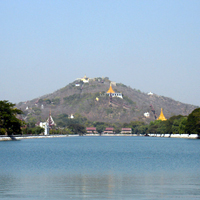destination / Mandalay

Mandalay is the third-largest city and the last royal capital of Myanmar Kingdom. It located 445 miles (716 km) north of Yangon on the east bank of the Ayarwaddy River. The population of Mandalay is around 1 million and is the capital of Mandalay Region.Mandalay is the economic point of Upper Myanmar and consider the centre of Myanmar culture. On 13 February 1857, King Mindon founded a new royal capital at the base of Mandalay Hill, it is Mandalay city. Despite Naypyidaw’s recent rise, Mandalay remains Upper Burma’s main commercial, educational and health center. Mandalay is located in the central dry zone of Myanmar at 21.98° North, 96.08° East, 64 meters (210 feet) above sea level. Its standard time zone is UTC/GMT +6:30 hours.
If you are interesting about Mandalay Tour Packages, please contact us anytime.
Mahamuni Pagoda
The Mahamuni Buddha Temple is a Buddhist temple and major pilgrimage site, located southwest of Mandalay. The Mahamuni Buddha image originally came from Arakan. It is much venerated in Myanmar. It is an expression of representing the Buddha’s life. According to legend, the Buddha visited the Dhanyawadi city of Arakan(Rakaing) in 554 BC. King Sanda Thuriya of Khanyawadi requested to do respect Buddha. So, Buddha did five likenesses of the Buddha when he was in Dhanyawadi. After casting the Great Image, the Buddha breathed upon it. Among of them, the fifth is the Mahamuni Buddha Image in Mandalay. The image is cast in bronze and weighs 6.5 tones and is erected on a pedestal 1.84 meters high and reaches a height of 3.82 meters. The Mahamuni Buddha Image is housed in a small chamber, seated on a throne in Bhumisparsa Mudra. This posture or Mudra symbolises Buddha’s vanquishing of Mara. The legs are crossed with feet turned inwards, and the right hand touches the ground calling the Earth to witness to his past good deeds.
Mandalay Palace
Mandalay Palace(Myanansankyaw shwenandaw) is the last Royal Palace of the Last Myanmar Kingdom. The Palace was constructed, between 1857 and 1859. It is also the part of King Mindon’s founding of the new royal capital city of Mandalay. The plan of Mandalay Palace largely follows the traditional Burmese palace design, inside a walled fort surrounded by a moat. The palace itself is at the centre of the citadel and faces east. All buildings of the palace are of one storey in height. The number of spires above a building indicated the importance of the area below. Mandalay Palace was the Primary Royal Palace of King Mindon and King Thibaw, the last two kings of the Myanmar Kingdom. After Third English-Myanmar War, the British changed the palace compound into Fort Dufferin. Throughout the British colonial era, the palace was seen the national primary symbol sovereignty and identity. Much of the palace compound was destroyed during World War II by allied bombing; only the royal mint and the watch tower survived. A replica of the palace was rebuilt in the 1990s with some modern materials.Today, Mandalay Palace is a primary symbol of Mandalay and a major tourist destination.
Shwe Nan Daw Kyaung
Shwenandaw Monastery is a historical monastery located near Mandalay Hill in Mandalay. It was built by King Mindon in the 19th century. The monastery was built in the traditional Burmese architectural style. King Mindon Min died on this building. King Thibaw Min, son of King Mindon moved this building from the palace to its current location. Shwenandaw Monastery is the single remaining major structure of the original wooden Royal Palace today. In 1880 the building was turned into a monastery, which hasn’t changed until today. It has not been a target of the bombardments of the allies in World War II. It consists mostly of teak wood, is richly ornamented with carvings and hints at the grandeur of the ancient royal palace.
Mandalay Hill
Mandalay Hill is a 240 metre (790 ft) hill. It is located to the northeast of Mandalay’s downtown. The name of city came from the hill. Mandalay Hill is known for its abundance of Pagodas and Monasteries, and has been a major Pilgrimage site for Buddhists for nearly two centuries. At the top of the hill is the Sutaungpyei (literally wish-fulfilling) Pagoda. A panoramic view of Mandalay from the top of Mandalay Hill alone makes it worthwhile to attempt a climb up its stairways. There are four covered stairways called Saungdan leading up the hill from the south, southeast, west and north, and convenient seats of masonry work line these stairways all the way up. You can climb up the Mandalay Hill with another way. A one-way motor road saves time and makes convenient for one who are unable to climb up the stairs, leading to an escalator and a lift to the pagoda at the summit.
If you want to see more about other interesting Destinations and Myanmar Tour Packages, please visit Tour Programs in our website.
